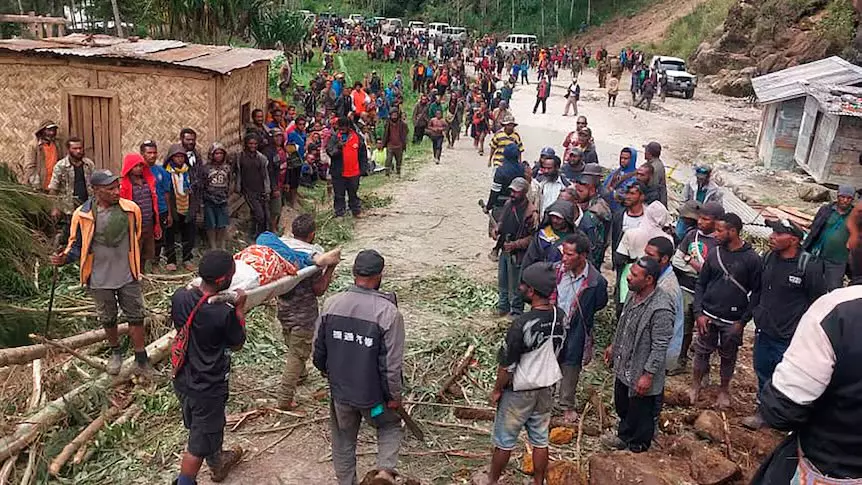
Over 670 killed in Papua New Guinea landslide: UN migration body
What is hampering the rescue and relief work is the ongoing tribal warfare in the Pacific Ocean island nation, making the rescue and relief work difficult

Revising its estimate of the death toll from a massive landslide in Papua New Guinea, based on calculations by Yambali village and Enga provincial officials, the International Organisation for Migration on Sunday (May 26) said more than 670 have died in the disaster.
Serhan Aktoprak, the chief of the UN migration agency's mission in the South Pacific island nation, said the revised death toll was based on calculations by Yambali village and Enga provincial officials that more than 150 homes had been buried by landslide on Friday (May 24). The previous estimate had been 60 homes.
“They are estimating that more than 670 people (are) under the soil at the moment,” Aktoprak told The Associated Press. Local officials had initially put the death toll on Friday at 100 or more. Only five bodies and a leg of a sixth victim had been recovered by Sunday (May 26).
No hope for survivors
Emergency responders in Papua New Guinea were moving survivors to safer ground as tons of unstable earth and tribal warfare, which is rife in the country's Highlands, threatened the rescue effort.
The South Pacific island's government meanwhile is considering whether it needs to officially request more international support.
Crews have given up hope of finding survivors under earth and rubble 6–8 metres (20–26 feet) deep, Aktoprak said. “People are coming to terms with this so there is a serious level of grieving and mourning,” he said.
Government authorities were establishing evacuation centres on safer ground on either side of the massive swath of debris that covers an area the size of three to four football fields and has cut the main highway through the province.
“Working across the debris is very dangerous and the land is still sliding,” Aktoprak said.
Threat from tribal rebels
Beside the blocked highway, convoys that have transported food, water and other essential supplies since Saturday (May 25) to the devastated village 60 kilometres (35 miles) from the provincial capital, Wabag, have faced risks related to tribal fighting in Tambitanis village, about halfway along the route. Papua New Guinea soldiers were providing security for the convoys.
Eight locals were killed in a clash between two rival clans on Saturday (May 25) in a longstanding dispute unrelated to the landslide. Around 30 homes and five retail businesses were burned down in the fighting, local officials said.
Aktoprak said he did not expect tribal combatants would target the convoys but noted that opportunistic criminals might take advantage of the mayhem to do so.
“This could basically end up in carjacking or robbery,” Aktoprak said. “There is not only concern for the safety and security of the personnel but also the goods because they may use this chaos as a means to steal.”
Tribal warfare hampering work
Longtime tribal warfare has cast doubt on the official estimate that almost 4,000 people were living in the village when a side of Mount Mungalo fell away.
Justine McMahon, country director of the humanitarian agency CARE International, said moving survivors to “more stable ground” was an immediate priority along with providing them with food, water and shelter. The military was leading those efforts.
The numbers of injured and missing were still being assessed. Seven people including a child had received medical treatment by Saturday (May 25), but officials had no details on their condition.
Medical facilities were buried along with houses, several small businesses, a guest house, school and gas station, officials said.
McMahon said there were other health facilities in the region, the provincial government was sending health workers and the World Health Organization was mobilising staff.
Disaster of immense scale
“There will be some support, but it's such a spread-out area that I think it will be quite a challenging situation,” McMahon said. “The scale of this disaster is quite immense.”
While Papua New Guinea is in the tropics, the village is 2,000 metres (6,600 feet) above sea level where temperatures are substantially cooler.
Papua New Guinea Defense Minister Billy Joseph and the government's National Disaster Centre director Laso Mana few from Port Moresby by helicopter to Wabag on Sunday to gain a firsthand perspective of what is needed.
Aktoprak expected the government would decide by Tuesday (May 28) whether it would officially request more international help.
The United States and Australia, a near neighbour and Papua New Guinea's most generous provider of foreign aid, are among governments that have publicly stated their readiness to do more to help responders.
Papua New Guinea is a diverse, developing nation with 800 languages and 10 million people who are mostly subsistence farmers.
(With agency inputs)

